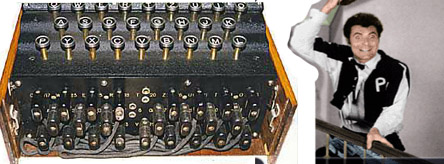
I found myself ciphering, working on a project to restore the audio from a few 1/4 inch tapes from the 1960s and two 78 rpm records from 1949. Unfortunately, there was not a handy, dandy Sony TC 580 (pic, pic 2). Long ago, tape machines offered 3 speeds - 1 7/8, 3 3/4, and 7 1/2 ips, or inches per second, meaning that's how far the tape would move across the head per second. The higher the ips, the better the quality. Top end machines also offered bi-directional recording and playback - which means, when the tape got filled up on the right take-up reel, you could play or record again on the same tape - in reverse direction. Well, while trying to de-cipher these tapes, all i had was a uni-directional Fostex mastering 2 track machine. Totally the wrong gear, especially since a lot of it was recorded at 3 3/4 ips. (The Fostex offered 7 1/2 and 15 ips. and just one direction). Was all lost? If we had to do this for an archive, we would have needed to get the right machine, but this job was just for fun. Quality control was not as much as an issue as being frugal in tough times. So - we used the Fostex. Most everything was played at double speed, and recorded digitally in an a/v workstation. Some of it was also, backwards and at double speed. Knowing that the speed is 2x, we know the amount of pitch shift needed to fix it. The answer is 12 semitones, or an octave. Think of a keyboard, there are twelve notes if you include the black and white keys. Each step is a semitone. It was a snap to pitch shift the material 12 semitones, and reverse it if you recorded it in reverse. Then the hard work of audio restoration began.
The same problem - wrong equipment, was there for the 78 rpm record project. All we had was a turntable with a top speed of 45 rpm. So - we played it at 45 rpm, and recorded the slow sounding blur into the a/v workstation. The question is, how many semitones do we need to increase it to correct for the slow 45 rpm speed??? The answer is pretty easy, but don't look yet if you want to cipher it yourself Jethro.
Think about it this way, and the answer is just too easy. If we had to adjust it to 90 rpm, meaning that is the proper speed of the record, we would just move it 12 semitones. So 90 rpm (2x speed) would equal 12 semitones. And so, 78 rpm / 90 rpm = x / 12 semitones. x = 10.4 semitones. And just to check out math, we know we must increase the playback rate by 1.733333333..etc times. (78 / 45). if 2x speed = 12 semitones, x speed = 6 semitones. And guess what, 1.733333 times 6 = 10.4 semitones. Woo Woo.
Just for kicks, I thought I'd include a sample. Here's a short snippet recorded off the tape, called chipmunks.mp3 - huh? what's that? Well, it is way too fast and backwards too. The original was recorded at a 3 3/4 (or 1 7/8 not sure) ips speed, and played at 7 1/2 ips which was recorded. Reverse the sample, and lower the pitch and you get this.
